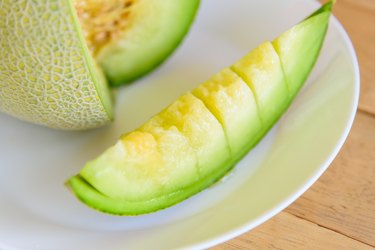
Cantaloupes (Cucumis melo), also known as muskmelons, are summer crops that take between two and three months to go from planting to harvest. In locations where the window for cantaloupe to develop is limited, cantaloupe seedlings can be started indoors in order to extend the growing season. Successful pollination is required for cantaloupe plants to produce fruit.
Early Stage Cantaloupe Plant
Video of the Day
Cantaloupes can be started indoors and transplanted into the garden or grown directly. The former method is preferable if you live in a climate with short summers, as it allows you to get a head start and essentially extend the growing season. Seedlings are ready to be transplanted when they have developed roots and have at least two fully developed leaves. It can take about six weeks to grow transplants. It is important to handle cantaloupe seedlings with care, as the roots are easily damaged.
Video of the Day
If you are growing cantaloupe from seed, you should wait until soil temperatures warm up to 65 degrees Fahrenheit to sow them. Ideal temperatures for germination are between 70 and 90 degrees. Applying black plastic mulch to the garden bed can help warm up the soil faster. All types of melons, including cantaloupe, grow best in soil that has a pH between 6.0 and 6.5. If grown in soil that has a pH below 6.0, the plants may not set fruit.
Caring for Cantaloupe Plants
Cantaloupe plants take between 65 and 88 days to reach maturity depending on the variety. They grow best when temperatures are between 65 and 75 degrees. Cantaloupe vines produce runners as they develop. At this time, the plants will benefit from feeding with a nitrogen-based fertilizer. However, it is just as important not to overfertilize cantaloupe with nitrogen, which can encourage leaf development at the expense of fruit production.
During most stages of growing cantaloupe, the plants require 1 to 2 inches of water a week. Cantaloupe plants should be watered deeply to at least 6 inches, so drip irrigation is recommended. It is important to water the roots and not the leaves to avoid foliar diseases.
A layer of mulch can help retain soil moisture but should only be applied once temperatures have reached 75 degrees. Once the fruit starts ripening, you should decrease the amount of water, especially during the final week. This will help melons develop a better and more robust flavor.
Cantaloupe Harvest Time
Cantaloupe plants produce flowers that must be pollinated by insects in order for the plants to set fruit. Without pollination, the fruit will not develop properly and will be inedible.
Once a cantaloupe plant flowers and pollination occurs, it takes between 30 and 40 days for the fruit to reach maturity. As harvest time approaches, the netting on the outer rind of the melon takes on a rough texture. You can tell that a cantaloupe melon is ready to be harvested when it separates from the vine with minimal twisting.
Cantaloupes ripen at different times. Each melon should be harvested when it is ripe rather than waiting to harvest all of the melons at once. After harvest, cantaloupes can be kept whole for two weeks at temperatures between 45 and 50 degrees.
- Utah State University Yard and Garden Extension: Cantaloupe (Muskmelon) in the Garden
- University of Minnesota Extension: Growing Melons in the Home Garden
- South Dakota State University Extension: Melons: How to Grow It
- University of Illinois Extension: Watch Your Garden Grow - Muskmelon
- South Dakota State University Extension: Melons, Melons, Melons!
- Clemson Cooperative Extension: Cantaloupe & Honeydew Melons